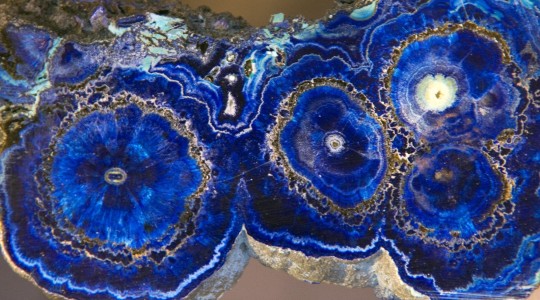Azurite, with its deep, vivid blue colour and striking crystal forms, has long been one of the most admired secondary copper minerals among collectors. Formed through the weathering of copper ore deposits, it often occurs alongside malachite, creating beautiful natural colour contrasts of blue and green. Its name derives from the Persian "lazhward", meaning "blue", and it has been prized since antiquity as both a pigment and a gemstone.
While azurite occurs in many copper-rich regions of the world, only a handful of localities have produced specimens of truly exceptional quality—renowned for their size, colour intensity, and crystal perfection. The following list highlights twenty of the world’s best and most famous azurite localities, each celebrated for its unique contribution to the mineral’s rich and colourful history.
1. Milpillas Mine, Sonora, Mexico - A truly classic location producing lustrous deep-blue azurite crystals sometimes exceeding 5 cm. Specimens show sharp prismatic forms with gem-like translucence and intense colour. Regarded by many as equal to or better than Bisbee and Tsumeb material.
2. Bisbee, Arizona, USA – Historic locality famous for “electric blue” azurite rosettes and crystal clusters on malachite. Mining ceased working long ago, making fine specimens highly sought after for their beauty and provenance.
3. Morenci Mine, Arizona, USA – Known for large, vivid spherical azurite masses and azurite–malachite pseudomorphs. Its specimens often show striking colour contrast between the two copper carbonates.
4. Tsumeb Mine, Namibia - Perhaps the most revered azurite locality in Africa. Produced razor-sharp crystals several centimetres long, often associated with malachite, smithsonite, and cerussite. Now closed for many years, making specimens increasingly rare and thus highly sought-after.
5. Chessy, Rhône, France - The classic European source of “Chessylite”, historically the modern type locality of azurite. Famous for deep-blue crystals and especially for the rich nodular masses collected since the 18th century.
6. Touissit Mine, Oujda, Morocco - Superb large, dark blue, almost black, crystals and striking associations with cerussite and anglesite. Moroccan azurite ranks among the finest from any modern producer.
7. Kerrouchene, Khénifra Province, Morocco - Known for more recent finds of brilliant blue azurite clusters with sharp, undamaged crystals in vuggy quartz matrix – a newer classic.
8. La Sal Mining District, Utah, USA - Yielded beautiful radiating, hedgehog-like clusters and stalactitic azurite–malachite combinations. Material is scarce and distinctly aesthetic.
9. Ting Tang, Wheal Basset and South Caradon Mines, Cornwall, England - Highly prized, but relatively modest, specimens of azurite sought by collectors for their historic value linked to these 19th-century copper mines.
10. Copper Queen Mine, Bisbee District, Arizona - Produced many of the iconic azurite–malachite specimens that define Bisbee’s mineralogy.
11. Tynagh Mine, Ireland - Known for unusual tabular azurite crystals with rich colour. Fewer specimens on the market, but important mineralogically.
12. Lavrion District, Greece - Ancient copper workings yielding crystalline and fibrous azurite forms with historical significance dating to classical times.
13. Broken Hill, New South Wales, Australia - Azurite occurs with malachite and cerussite in dense oxide zones, often forming beautiful display pieces.
14. Shilu Mine, Guangdong Province, China - High-quality azurite plates and rosettes from China’s most important copper carbonate locality; production sporadic.
15. Katanga District, Democratic Republic of Congo - Produces striking blue azurite crystals associated with malachite, sometimes pseudomorphous – colourful and striking. Overall, azurite is rare in Katanga and the best specimens came from Shangulowé mine.
16. Malbunka Copper Mine, Areyonga, Northern Territory, Australia - Extremely unusual flattened, plate-like aggregates of azurite embedded in kaolinite siltstone matrix. Often called 'Azurite Suns', no other world locality produces examples of such quality.
17. Tiger (Mammoth–St. Anthony Mine), Arizona, USA - Produced smaller but sharp and vibrant azurite crystals, often pseudomorphed by malachite.
18. Copper Mountain District, Greenlee County, Arizona, USA - Another prolific Arizona producer noted for rich blue crystalline and botryoidal forms.
19. Concepcion del Oro, Zacatecas, Mexico - Produced dark indigo-blue azurite crystals and aggregates; notable for excellent contrast with quartz matrix.
20. Nchanga Mine, Zambia - Less common on the market but produces elegant deep-blue azurite crystals on a contrasting limonite matrix — highly aesthetic and collectible.
The Assay House—Mineral Dealers of quality Mineral Specimens
Image Credits - CC Tony Hisgett

